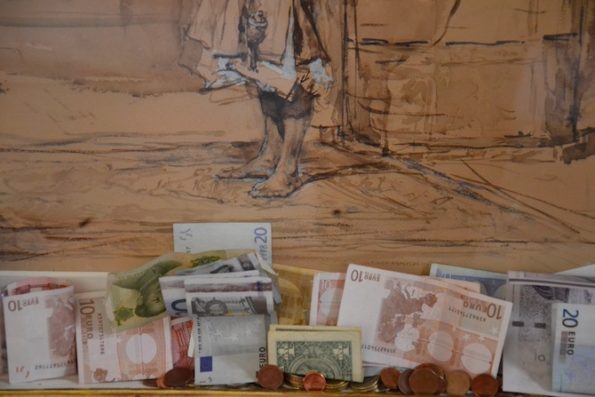Search
To search for an exact match, type the word or phrase you want in quotation marks.
A*DESK has been offering since 2002 contents about criticism and contemporary art. A*DESK has become consolidated thanks to all those who have believed in the project, all those who have followed us, debating, participating and collaborating. Many people have collaborated with A*DESK, and continue to do so. Their efforts, knowledge and belief in the project are what make it grow internationally. At A*DESK we have also generated work for over one hundred professionals in culture, from small collaborations with reviews and classes, to more prolonged and intense collaborations.
At A*DESK we believe in the need for free and universal access to culture and knowledge. We want to carry on being independent, remaining open to more ideas and opinions. If you believe in A*DESK, we need your backing to be able to continue. You can now participate in the project by supporting it. You can choose how much you want to contribute to the project.
You can decide how much you want to bring to the project.

One of the relevant pieces of art news over the last few days has been the crowd-funding initiative set up by MNAC; proposing that citizens finance the purchase of the piece “La Plegaria” (The Prayer) by Fortuny, given the lack of funds on the museum’s part. Rekindling the debate about who should finance culture. It’s worth recalling some of the conversations that arose during the conference “La responsabilidad sociocultural de la empresa” (The sociocultural responsibility of businesses), organised by the CaixaForum a month ago. In which they proposed to foment a model of mixed management: private investment, public investment and self-financing (tickets, rents of spaces, etc.). However, it soon shifted from the harmonious theory to reproaching the lack of involvement between some sectors and others: foundations safeguard the collectors, and direct their retorts to the State and to the museums; the collectors also make claims on the State and the museums; the museums defend their status and once again criticise the State; and the State…has no representation whatsoever.
Some of demands on the part of company foundations were: modification of the law of sponsorship to offer greater rebates to the collector, giving as an example MOMA, that houses a multitude of programmes thereby promoting the much renowned American philanthropy; relaxing the regulations of the Conservations Departments so that there aren’t as many impediments preventing certain works being exhibited in other places (reference was made to Guernica); transparency in museum management, making the strategic plans of the museum available to the public.
What in the end was being demanded was management under the auspices of effectiveness and efficiency, principles that are being emphasised (particularly efficiency), now that the money seems to have evaporated. It’s true that many have managed to keep good programmes going, working with modest budgets, but my eyes are drawn to the large grants. To the many star architects, star artists, star curators….the majority foreigners. So much stargazing has finally run this boat aground and our professionals are fleeing to destinations where they are valued.
Any proposal seemed reasonable until Juan Alfaro (general secretary of the Club de Excelencia en Sostenibilidad), spokesperson for the sector of collectors, emitted the words that everyone had been dreading: “one needs to know how one can intervene in a museum’s programming…that the museums ask us, what do you expect from us as a cultural institution? What performance or artists would you like to see?”. He didn’t resign himself to sticking with the slogan “every day one has to make institutions more like businesses”, but went beyond the competences corresponding to his sector, allowing the collectors to meddle in tasks that don’t fall within their remit. According to the same rule, if by giving money one has decision-making powers, why didn’t it happen with the general populace, when all that funding left the public coffers? Here lies the fear that often arises when thinking of private funding, that the rights and duties of purchase are transposed to sponsorship.
What is the main problem? Ignasi Miró, director of the ambit of culture in the Fundación la Caixa, didn’t beat around the bush: “Culture finds itself at a risk of social exclusion”. He visualised the phrase with a piece of data: one visitor comes 4 times a year to the CaixaForum, therefore, its audience is not so much a million people, as 200.000. By asking, “For whom are we working if the public is increasingly minority though with a greater capacity for demand?”. He hits on the solution for the problem we face today: a person who is offered adequate training is one who repeats. Question of the session: “Have we invested the necessary energy in creating social awareness?”
Neither education nor cultural mediation is cultivated therefore the rift between art and society seems ever greater. It’s a grave political irresponsibility to consider the artistic sphere as totally dispensable, as by doing so they eliminate the symbolic capital that it brings to society. At a time when everything has to be justified in terms of economic impact, it is not hard to augur the bankruptcy of the common intellect towards which they are pushing us. We all have the right to access culture and with it also certain responsibilities. I only hope that the case of Fortuny doesn’t make the State forget what their responsibilities are.

Alba Benavent is an eternal apprenticeship. An art historian, she observes the artistic world under a curious as well as analytical look. Research has always been his favorite subject. With a restless mind, almost as much as his feet, he proposes to make the intricacies of the artistic bar from the reflection around the different performances of his agents more accessible. She writes the blog elchiringuitodelarte.
"A desk is a dangerous place from which to watch the world" (John Le Carré)